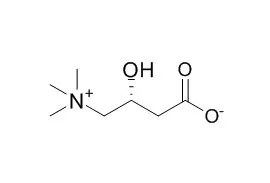| Description: |
L-carnitine is constituent of striated muscle and liver, it is used therapeutically to stimulate gastric and pancreatic secretions and in the treatment of hyperlipoproteinemias. L-Carnitine inner salt regulates the PTEN/Akt/mTOR signaling pathway, and enhances axonal plasticity while concurrently ameliorating oxidative stress and increasing oligodendrocyte myelination of axons, thereby improving WMLs and cognitive impairment in a rat chronic hypoperfusion model. |
| Targets: |
Akt | mTOR | PTEN |
| In vitro: |
| Neurochem Res. 2013 Nov;38(11):2336-41. | | L-carnitine exposure and mitochondrial function in human neuronal cells.[Pubmed: 24005823] | L-Carnitine inner salt is a naturally occurring substance required in mammalian energy metabolism that functions by facilitating long-chain fatty acid entry into cellular mitochondria, thereby delivering substrate for oxidation and subsequent energy production. It has been purposed that L-Carnitine inner salt may improve and preserve cognitive performance, and may lead to better cognitive aging through the life span, and several controlled human clinical trials with L-Carnitine inner salt support the hypothesis that this substance has the ability to improve cognitive function.
We further hypothesized that, since L-Carnitine inner salt is an important co-factor of mammalian mitochondrial energy metabolism, acute administration of L-Carnitine inner salt to human tissue culture cells should result in detectable increases in mitochondrial function.
METHODS AND RESULTS:
Cultures of SH-SY-5Y human neuroblastoma and 1321N1 human astrocytoma cells grown in 96-well cell culture plates were acutely administered L-Carnitine inner salt hydrochloride, and then, mitochondrial function was assayed using the colorimetric 2,3-bis[2-methoxy-4-nitro-5-sulfophenyl]-2H-tetrazolium-5-carboxyanilide inner salt cell assay kit in a VERSAmax tunable microplate reader. Significant increases in mitochondrial function were observed when human neuroblastoma or human astrocytoma cells were exposed to 100 nM (20 μg L-Carnitine inner salt hydrochloride/L) to 100 μM (20 mg L-Carnitine inner salt hydrochloride/L) concentrations of L-Carnitine inner salt hydrochloride in comparison to unexposed cells, whereas no significant positive effects were observed at lower or higher concentrations of L-Carnitine inner salt hydrochloride.
CONCLUSIONS:
The results of the present study provide insights for how L-Carnitine inner salt therapy may significantly improve human neuronal function, but we recommend that future studies further explore different derivatives of L-Carnitine inner salt compounds in different in vitro cell-based systems using different markers of mitochondrial function. |
|
| In vivo: |
| Gene. 2015 Jan 10;554(2):148-54. | | L-Carnitine intake prevents irregular feeding-induced obesity and lipid metabolism disorder.[Pubmed: 25445284] | L-Carnitine inner salt supplementation has been used to reduce obesity caused by high-fat diet, which is beneficial for lowering blood and hepatic lipid levels, and for ameliorating fatty liver. However, whether L-Carnitine inner salt may affect irregular feeding-induced obesity and lipid metabolism disorder is still largely unknown.
METHODS AND RESULTS:
In the present study, we developed a time-delayed pattern of eating, and investigated the effects of L-Carnitine inner salt on the irregular eating induced adiposity in mice. After an experimental period of 8 weeks with L-Carnitine inner saltsupplementation, L-Carnitine inner salt significantly inhibited body weight increase and epididymal fat weight gain induced by the time-delayed feeding. In addition, L-Carnitine inner saltadministration decreased levels of serum alanine aminotransferase (GPT), glutamic oxalacetic transaminase (GOT) and triglyceride (TG), which were significantly elevated by the irregular feeding. Moreover, mice supplemented with L-Carnitine inner salt did not display glucose intolerance-associated hallmarks, which were found in the irregular feeding-induced obesity. Furthermore, quantitative real-time polymerase chain reaction (qRT-PCR) analysis indicated that L-Carnitine inner salt counteracted the negative alterations of lipid metabolic gene expression (fatty acid synthase, 3-hydroxy-3-methyl-glutaryl coenzyme A reductase, cholesterol 7α-hydroxylase, carnitine/acylcarnitine translocase) in the liver and fat of mice caused by the irregular feeding.
CONCLUSIONS:
Therefore, our results suggest that the time-delayed pattern of eating can induce adiposity and lipid metabolic disorders, while L-Carnitine inner salt supplementation might prevent these negative symptoms. |
|






 Cell. 2018 Jan 11;172(1-2):249-261.e12. doi: 10.1016/j.cell.2017.12.019.IF=36.216(2019)
Cell. 2018 Jan 11;172(1-2):249-261.e12. doi: 10.1016/j.cell.2017.12.019.IF=36.216(2019) Cell Metab. 2020 Mar 3;31(3):534-548.e5. doi: 10.1016/j.cmet.2020.01.002.IF=22.415(2019)
Cell Metab. 2020 Mar 3;31(3):534-548.e5. doi: 10.1016/j.cmet.2020.01.002.IF=22.415(2019) Mol Cell. 2017 Nov 16;68(4):673-685.e6. doi: 10.1016/j.molcel.2017.10.022.IF=14.548(2019)
Mol Cell. 2017 Nov 16;68(4):673-685.e6. doi: 10.1016/j.molcel.2017.10.022.IF=14.548(2019)